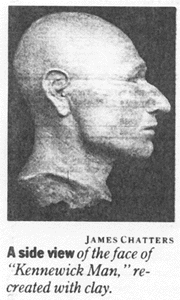 He
was about 5 feet 9 inches tall, a vigorous middle-age man who for years
had carried a spear point lodged in his hip, apparently without ill effect.
He
was about 5 feet 9 inches tall, a vigorous middle-age man who for years
had carried a spear point lodged in his hip, apparently without ill effect.
By Guy Gugliotta (Seattle Times 27 July 1999)
 He
was about 5 feet 9 inches tall, a vigorous middle-age man who for years
had carried a spear point lodged in his hip, apparently without ill effect.
He
was about 5 feet 9 inches tall, a vigorous middle-age man who for years
had carried a spear point lodged in his hip, apparently without ill effect.
He had a long face, a long, low brain pan, a prominent nose and skull measurements that distinguished him from most, if not all, of the modern world's distinct human populations.
He bore no resemblance to any modern Native American, and some scientists have suggested that he was more Caucasoid than Asian. This possibility has made him perhaps the most celebrated and controversial skeleton ever found in North America.
"Kennewick Man," discovered by accident near the banks of Washington state's Columbia River three years ago, is believed to have lived and died more than 9,000 years ago, thousands of years before Leif Ericson and Christopher Columbus made landfall in the New World.
His is one of perhaps three dozen ancient skeletons found in the Western Hemisphere whose facial dimensions have little in common with today's Native Americans. Discovered in locations as diverse as a south Florida sinkhole and a cave in Brazil's central plateau, they are anthropological anomalies.
Almost from the moment of his discovery, Kennewick Man became a focal point in the debate, over the origins of America's first inhabitants. He also has become the center of attention in an ongoing conflict between scholars and Native Americans over custody of such national antiquities.
Today, a team of Interior Department scientists examining Kennewick Man's remains was meeting in Walla Walla with five Native American tribal groups to report on the team's investigation and announce plans to continue their efforts to better understand who Kennewick Man was and where he came from.
The team members have new information. They now believe that Kennewick Man, currently stored in the Burke Museum at the University of Washington, was formally buried and that he lay relatively undisturbed until wave action gouged away his resting place and tumbled his bones into the river. They also believe parts of his body may have been painted with a red dye that stained the bones as soft tissue decomposed.
Most important, physical anthropologist Joe Powell, an Interior Department team member from the University of New Mexico, ran Kennewick Man's skull measurements through a database describing "almost 300 different populations" worldwide and found "no matches -- Kennewick Man does not fit in."
The remains thus cast further doubt on the migration theory that has dominated American anthropology for most of this century: The hemisphere was settled in one mass migration about 11,500 years ago by Asiatic peoples crossing an Ice Age land bridge from Siberia to Alaska across what is now the Bering Strait.
The skeleton and some other recent finds suggest multiple migrations from different points of origin. Other ancient remains, including some more than 11,000 years old, show affinities with native Australians, African bushmen, Polynesians, medieval Scandinavians and Ainu from northern Japan, as well as central, southern and southeast Asians.
Kennewick Man may have been a Caucasoid, with the long face, beak-nosed facial type most frequently -- but not exclusively -- associated with Europeans. In fact, many anthropologists suggest that some ancient Asians may have looked as Kennewick Man looked today because they needed a longer face and heavier jaw to eat tougher food.
"These skeletons are all over the place. It makes it very diffIcult to make statements about who got here first," said Powell. "Kennewick becomes very important, because it provides another glimpse of this early period.
Kennewick Man comprises more than 380 bones and bone fragments recovered from a 300-square-foot section of river bottom. Team leader Francis McManamon, the Interior Department's chief consulting archaeologist, said the skeleton is 80 percent to 90 percent complete. The bones were not worn down, McManamon added, an indication that they had not been long in the Columbia River.
Powell also explained that while the Kennewick bones showed "rodent gnawing," there was no evidence that they had been disturbed by dogs or other large scavengers. This suggests deliberate burial rather than a solitary death in the wild.
The investigators also found some bones that had been stained red, suggesting ceremonial treatment at burial.
"As the body decomposed, red ochre from the skin may have left a film on the bones," Powell said. But he acknowledged that the dye may simply have come from iron deposits in the river sediment.
The team found nothing that suggested a cause of death, but easily ruled out the spear wound, since bone had re-grown around the point, an indication that the man had carried it for several years.
The team also had little to say about Kennewick Man's ethnic origin.
"Part of the problem is that the groups we see today may not have existed 15,000 years ago, and continual re-migration has also muddled the picture," Powell said. "This skull is relatively long, but over time heads got rounder. The same thing happened in Europe."